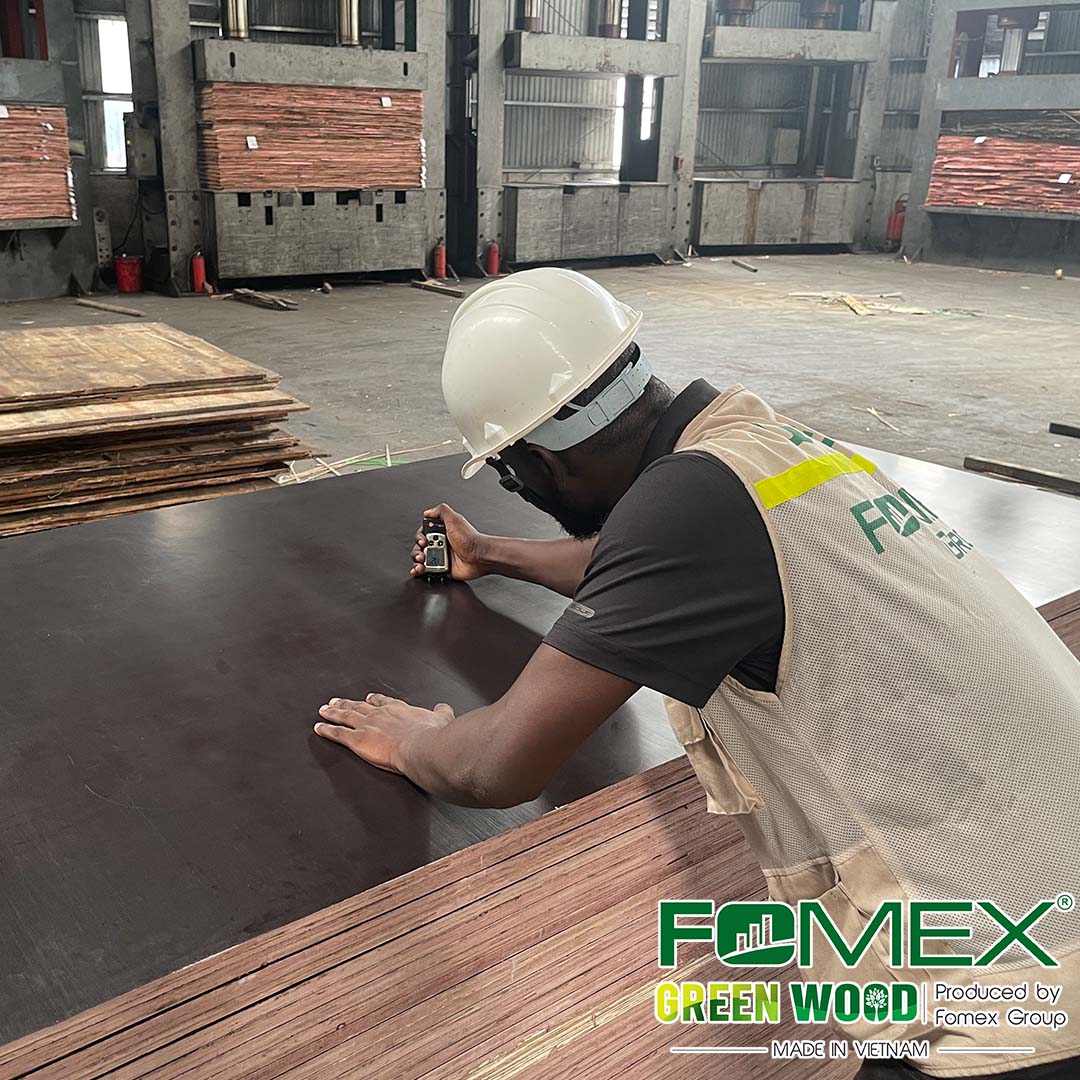The moisture content of plywood may seem like a small technical detail, but it has a powerful impact on the product’s strength, stability, and long-term performance.
For importers, furniture manufacturers, and builders, understanding this factor is essential to avoid warping, delamination, and structural failure.
At FOMEX GREENWOOD, we ensure that every plywood panel—whether for furniture, construction, or packing—is produced with carefully controlled moisture content to guarantee long-term durability and export consistency.

1. What Is Moisture Content in Plywood?
Moisture content refers to the percentage of water retained in the wood fibers of a plywood sheet. It directly affects the material’s dimensional stability and bonding quality.
In sustainable plywood production, moisture levels are carefully measured during each manufacturing stage—from veneer drying to hot pressing and final inspection.
For export-grade Vietnam plywood, the optimal moisture content is typically maintained between 8% and 12%.
This range provides the perfect balance: dry enough to prevent fungal growth or shrinkage, yet moist enough to ensure flexibility and bonding integrity when used in various climates.
To achieve this balance, FOMEX GREENWOOD employs calibrated moisture meters and industrial hot-air dryers to monitor every batch.
This process ensures compliance with FSC® standards and CARB-P2 regulations, both of which prioritize safe and eco-friendly production practices.
2. Why Moisture Control Matters for Durability
Plywood durability is not only about density or core type—it largely depends on how well the panel can resist moisture changes during shipping, storage, and usage.
If the moisture level is too high, the board may expand and lose structural stability.
If it’s too low, internal cracks or glue line separation may occur.
Dimensional stability: Balanced moisture content prevents warping or swelling when exposed to humidity variations.
Adhesion strength: Proper drying ensures the WBP glue or melamine glue can bond veneers tightly without delamination.
Formaldehyde emission control: Consistent drying reduces the risk of formaldehyde release, ensuring CARB-P2 Plywood and E0/E1 compliance.
Longevity: Correct moisture levels maintain product integrity for years, even in fluctuating environments such as Europe and the Middle East.
As part of our Sustainable Plywood approach, moisture management helps prolong product life, reduces waste, and contributes to eco-friendly plywood applications in furniture and green construction.
3. How FOMEX GREENWOOD Controls Moisture Content
At FOMEX GLOBAL, moisture control is integrated into every production phase to meet international standards such as FSC®, EUDR, and EPA TSCA Title VI.
Veneer Drying
Fresh veneers are first passed through automated drying lines until they reach a moisture level of 8–10%. This step ensures the layers are consistent before gluing and pressing.
Pressing
During hot pressing, WBP phenolic glue or melamine glue bonds layers under controlled temperature and humidity, ensuring proper curing.
The panels are then in ambient air for 24–48 hours to stabilize internal moisture distribution.
Final Moisture Inspection
Every plywood panel undergoes a final moisture content check before packaging. This ensures it meets export specifications for Vietnam Plywood Export markets in the EU, USA, and Middle East.
For specialized projects—such as Film Faced Plywood specs used in concrete formwork—FOMEX offers customized moisture levels to ensure higher reuse cycles and reduced surface cracking.
4. Effects of Improper Moisture Content
Improper moisture levels can lead to costly issues that affect the performance and appearance of the finished product:
Warping & twisting: Over-dried or uneven panels may bend during storage or installation.
Delamination: Excess moisture weakens the glue line, causing separation between veneer layers.
Mold & decay: High moisture creates an environment conducive to fungus and bacterial growth.
Dimensional mismatch: When plywood with high moisture is used in dry indoor conditions, it may shrink or crack.
By keeping plywood moisture content stable and consistent, FOMEX GLOBAL minimizes these risks and ensures reliable performance for importers and end-users alike.
5. Standards and Compliance in Moisture Regulation
Moisture content control aligns directly with international quality and sustainability standards.
FOMEX products meet all major certification requirements, ensuring durability and traceability for global buyers.
FSC® Certification: Confirms responsible wood sourcing and traceability through the Chain of Custody.
CARB-P2 Compliance: Ensures low formaldehyde emission levels for indoor safety.
EUDR Compliance: Verifies deforestation-free and legally sourced materials in line with EU import regulations.
Our strict internal Quality Control (QC) and export documentation systems include recorded moisture levels on every packing list and inspection report.
This transparency gives partners the confidence they need for long-term cooperation.
Conclusion: Stable Moisture, Stable Partnership
Maintaining ideal moisture content in plywood is not just about production—it’s about protecting quality and building trust across the supply chain.
With precise control, certified compliance, and open communication, FOMEX GLOBAL helps importers secure reliable and FOMEX GREENWOOD Plywood for every application.
Contact us: qc@fomexgroup.vn
Call: 877034666
Contact FOMEX GLOBAL to Request a Quotation →
© 2025 FOMEX GLOBAL | Vietnam Trusted Plywood Exporter | fomexgroup.vn
